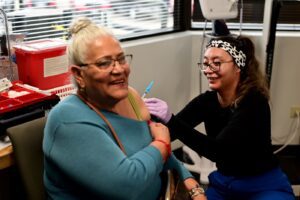Mike Scott was a wide-eyed Eagan firefighter fresh out of training when he went on one of those calls that will be with him forever.
Scott, at age 18, walked into a home on a report of a man who took his life. The man, Scott discovered, was his elementary school gym teacher.
“You think back of when you were an 18-year-old kid and experienced that, and was told to just suck it up,” said Scott, who became the city’s first full-time fire chief in 2006, after 19 years as a volunteer firefighter. “It was like, ‘Do you want to go out and get a beer afterward? And it was like, ‘No, I really want to talk to somebody, because when I close my eyes all I can see is my teacher.’ ”
The importance of the mental and physical health of firefighters has progressed since those days, with Eagan and many other departments now requiring that they attend critical incident stress debriefings after traumatic calls and offering up other resources. But there is still a long way to go, city and state fire officials say.
Leading the effort is the Minnesota Firefighter Initiative, an advocacy organization that gives firefighters the tools they need to prioritize and protect their health. It focuses on the three problems most commonly experienced by those in the fire service:
- Cardiovascular disease.
- Cancer.
- Emotional trauma.
Since its inception in 2016, MnFire instructors — current and former firefighters and health experts — have given free health and wellness training to 434 departments, reaching more than two-thirds of the state’s 20,000 firefighters.
The effort got a boost in November with a $400,000 grant from the state’s Fire Service Advisory Committee. It will allow MnFire to not only bring an initial two-hour awareness training on the three common health issues to more firefighters but also give those who already have had it a “deep dive” on each of them.
“If you’ve been in the fire service for any length of time you’ve been touched by all three of these … that’s absolutely undeniable,” said Steve Shapira, a former St. Paul fire captain who helped write the initial MnFire training. And as an instructor, he shares the story of his 2014 diagnosis with non-Hodgkin’s B-cell lymphoma, which he believes was caused by the roughly 1,000 smoke, fire and hazardous materials calls during 17-year career.
MnFire also has been leading a state legislative initiative, called the Hometown Heroes Assistance Program, to improve access to care for firefighters in need of treatment for cancer, cardiac care and emotional trauma issues. MnFire offers a confidential, toll-free helpline (888-784-6634) for firefighters in crisis, as well.
The efforts are a “cry out for help” from firefighters, said Shapira, whose cancer diagnosis forced him to retire from firefighting in 2014 at age 47. He calls himself “one of the lucky ones.”
“It’s tragic. We’re dying,” Shapira said, adding that his St. Paul firefighter friend Mike Paidar died this past August of acute myeloid leukemia at age 53. “The pride it takes for this industry to cry out for help is beyond description to anyone who is not in public safety. We’re self-sufficient. We don’t create problems; we fix your problems on your worst day.”
ABOUT SURVIVING
Wayne Kewitsch joined MnFire as its executive director in January, bringing a personal perspective to the organization after two sudden cardiac arrests this past summer forced him to retire as Richfield’s fire chief at age 56.
On July 1, Kewitsch’s wife, Ruth, found him at their Edina home slumped in a chair unresponsive and turning blue. Their 24-year-old son, Jack, ran up from the basement and began CPR. Paramedics from the Edina Fire Department shocked Kewitsch once in the house and twice more in the ambulance before his heart finally stayed in normal rhythm.
At M Health Fairview University of Minnesota Medical Center, two stents were put in his left anterior descending coronary artery, which was 80 percent blocked.

“I felt great after the stents were in, and I got discharged 51 hours later,” he said. “I was going to cardiac rehab, working hard, losing weight, doing all the things that I was supposed to do, and looking forward to getting back to work.”
But on Aug. 21, Kewitsch had his second cardiac arrest. Kewitsch and his wife were on U.S. 169 heading north to a friend’s cabin when Kewitsch, who was driving, lost consciousness south of Garrison, Minn. Ruth was able to grab the wheel, but their SUV ended up 40 feet in a cattail marsh.
Emily Roeder and her husband, Matt, who were driving behind them, pulled over, called 911 and waded in the marsh to help. Roeder, who is an intensive care nurse at Mercy Hospital in Coon Rapids, started CPR. Kewitsch was flown by helicopter to the Twin Cities, where surgeons implanted a cardiac defibrillator.
“They told me I am one very, very fortunate individual,” Kewitsch said. “Everything worked properly for me, both times. Nationwide, only about 14 percent of people that suffer a sudden cardiac arrest survive, and of that number only 8.2 percent survive neurologically intact. And there are no statistics about people who survive two.”
Kewitsch said his two brushes with death reinforced in him the importance of focusing on the health dangers firefighters face. Education about how to navigate the health challenges associated with the job, and corresponding lifestyle changes, are critical, he said.
“When you are a firefighter, we know there’s a moral imperative to your job,” he said. “We know it’s dangerous and we know we’re going to be put in life or death situations. But we need to be able to give our firefighters the tools and knowledge to mitigate those dangers as much as we possibly can so that they continue to do their job and that they can be healthy, safe and have a nice long life.”
FACING A GREATER RISK
The addition of Kewitsch to the MnFIRE team comes at a critical time.
Studies have found that firefighters are at a greater risk of cancer, due to smoke and hazardous chemicals they are exposed to in their work. And firefighters and paramedics are twice as likely as the general public to experience PTSD, according to the International Association of Fire Fighters. In Minnesota, four to six active firefighters die from suicide each year.
Cancer is the most dangerous threat to firefighter health and safety. Cancer caused 66 percent of the career firefighter line-of-duty deaths from 2002 to 2019, according to data from the IAFF. Heart disease caused 18 percent of line-of-duty deaths in the same period.
Firefighters have a 9 percent higher risk of being diagnosed with cancer and a 14 percent higher risk of dying from it than the general U.S. population, according to research by the CDC/National Institute for Occupational Health and Safety.
Kewitsch also noted that most firefighter cancer deaths typically are not officially recognized as being in the line of duty.
Shapira, the former St. Paul fire captain, was denied workers’ compensation because the city determined his cancer was not a line of duty injury and not among the presumptive illnesses in state law that would grant such benefits. He appealed the decision and sued the city. It was settled out of court in 2018.
Shapira now works as the state director of the Firefighter Cancer Support Network.
Scott’s dad, George, was a volunteer firefighter in Eagan for 21 years when he got esophageal cancer at age 56 and died of it five years later in 1997. Firefighters have a 62 percent higher risk of getting esophageal cancer, and a 39 percent increased risk of dying from it, according to the research.
Scott is convinced the dangers of firefighting caused his dad’s cancer.
“In my dad’s era, they didn’t wear the air tanks that we wear now,” he said. “They went into a fire and they didn’t wash their gear afterward, because they weren’t aware of the dangers of not cleaning it.”
A few years ago, Eagan decided it would begin to change the color of the new fire department’s vehicles from red to white, a color that signifies cleanliness, Scott said. The newest rig incorporates new ideas on preventing cancer for firefighters and keeping them safe, he said, including a clean cab with a self-contained breathing apparatus and a warm water decontamination line to clean gear at scenes.
Eagan has taken other steps at fire stations, too, like putting up MnFire logos in fitness areas and signs reminding firefighters not to wear gear in clean areas.
“These are constant reminders for them not to forget about the MnFire training that they’ve had and why it’s important,” Scott said. “And it’s nice to hear comments from your firefighters that they really feel like you’re trying to take care of them.”





